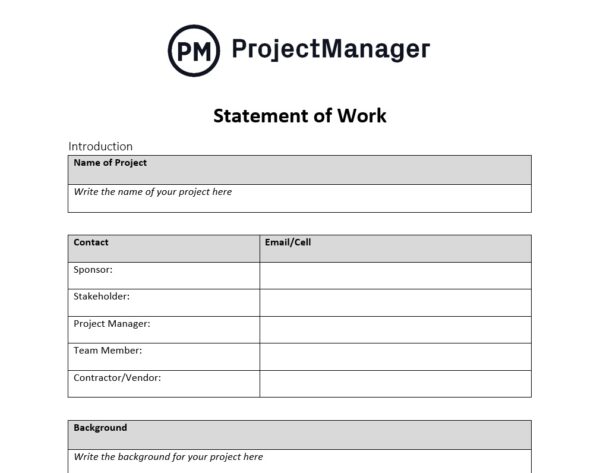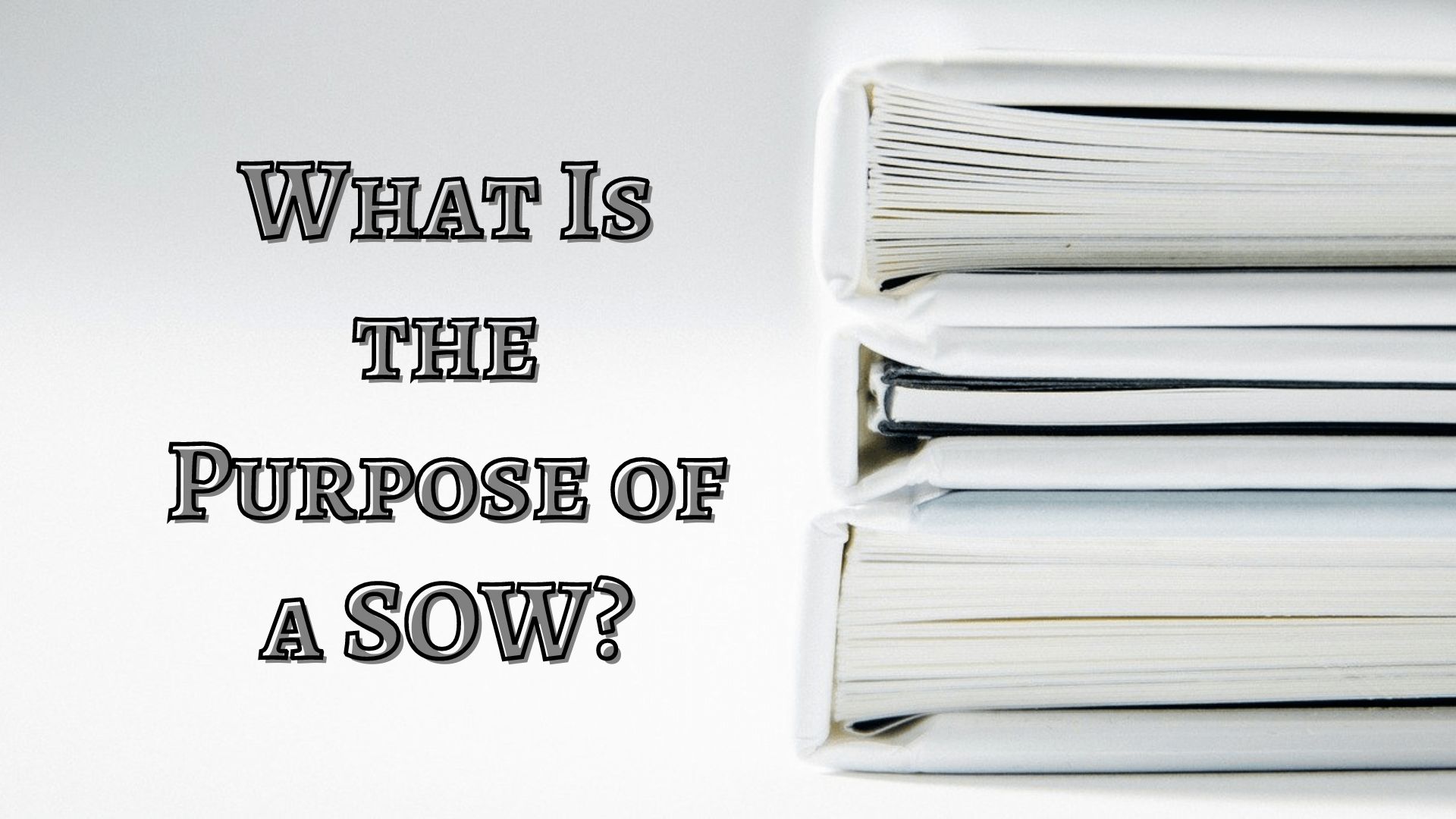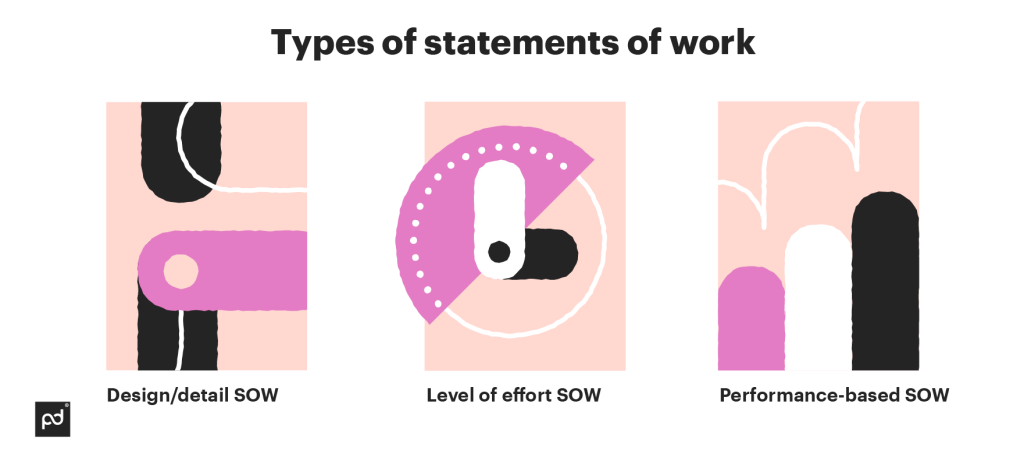What is a SOW in Project Management? (Complete Guide)
Do you want your objectives and deliverables to be communicated effectively? Well, a statement of work can be your medium. In the ever-evolving world of project management, the importance of a well-crafted Statement of Work (SoW) can’t be overstated. It ensures alignment between project stakeholders and effective management of the project scope.
In the future, expect to see a greater emphasis on collaboration in shaping the SoW, with clear and effective communication driving project success. But what is it exactly, and how do you create a well-optimized SOW? If you have these questions in your head, be aligned with us and get everything answered. This is just the tip of the iceberg, so let’s dive deeper into the world of SOW in project management.
What Is a Statement of Work (SOW) In Project Management?

A Statement of Work (SOW) is a foundational document that outlines the project scope, deliverables, timelines, location of work, and the terms and conditions of payment. It serves as the blueprint of a given project, specifying what needs to be achieved, how it should be done when it needs to be completed, and what costs are involved. Understanding the SOW in project management can significantly enhance your skill sets, driving successful project completions.
When it comes to creating SoWs, it often falls into the hands of those managing the project. They’re the ones responsible for ensuring the agreed-upon scope of services is completed on time and on budget, creating efficiencies, negotiating with suppliers, mitigating risks, and spotting savings opportunities.
What is The Difference Between SoW & Contract?
The distinction between a SoW and a contract, or services procurement, is essential to note. While each serves a purpose in project execution, a SoW focuses on the practicalities of the services – the ‘what,’ ‘how,’ and ‘when.’ Meanwhile, a contract typically formalizes the agreement and details legal and monetary aspects. With all this in mind, it’s wise to be aware that there are different types of SoWs, each suited to different project needs and management styles. So, while a SoW might be indispensable, it’s equally crucial to ensure that your SoW is adaptable – an asset in today’s agile, iterative project environments.
What Does SOW Stand for In Business and Project Management?
Statement of Work, or SOW as it is commonly abbreviated, is a critical document in the realm of project management. It essentially outlines the what, when, and how of the project. As you delve into the nitty-gritty of project management, it’s hard to miss the significance of this comprehensive document.
To understand what is SOW in project management, envision it as a guiding light for the project team. It meticulously details the expectations, responsibilities, deliverables, timelines, cost estimates, and the project’s overall scope. The meaning of SOW in project management changes slightly in agile environments, where adaptability is key. In such contexts, it maintains its role as a guide but is flexible enough to accommodate changing requirements and specifications, a significant cause of project challenges, according to the Standish Group’s CHAOS Report.
What Is the Purpose of a Statement of Work (SOW)?

A comprehensive, clear SOW is vital for a project to run smoothly and efficiently. It reduces risk and significantly ups the chances of project success. Keep your project on track, minimize misunderstandings, and ensure your project’s ultimate success through the creation of an effective SOW. It’s a crucial tool, the importance of which you should never underestimate.
- A Statement of Work contains the blueprint.
- It explains the purpose and scope of the project.
- Outlined within its pages is a holistic view of the project.
- This includes tasks, timelines, resources, special requirements, expected outcomes, and project team details.
- The narrative considers the contractor’s needs and requirements to offer these products and services.
- It is a tailored guiding tool unique to each project, aligning all stakeholders from the start to ensure everyone’s on the same page.
- The SOW is a more comprehensive document providing an overview of the project.
- It’s a part of the larger Statement of Work, making it a shorter project document.
What is the Importance of a Statement of Work (SOW)?
You may find yourself buried under heaps of project management paperwork. Yet, amid all the clutter, the Statement of Work (SOW) stands tall as one of the most critical documents. It’s akin to the identity card of your project if you will. When you’re asking, “What is SOW in project management?”, think of it as a comprehensive overview of the project scope. It’s not merely a document but a tool used internally or externally to govern project activities. SOW, meaning in project management, extends beyond a simple document – it’s a legally binding agreement that the project’s client must approve before any work can commence.
1. Helps to enter the development phase
A well-planned SOW is significant as a project enters the development phase. It sets the stage for successfully leading a project over the finish line, on schedule, and within the budget. It lays out everything from project requirements to acceptance criteria and payment terms. This sort of clarity is invaluable for all team members, whether they’re collaborators or contracted to work on the project.
2. Depicts critical reference
The SOW is a critical reference point for vendors and contractors bidding to work on the project. The SOW in project management is the touchstone against which their work and performance are measured. In fact, the SOW’s role extends beyond the project’s lifespan, becoming a part of the project’s historical archives for future reference.
3. Important to establish the structure
In short, the SOW is a cornerstone document in project management, establishing structure, setting expectations, and paving the way for a smooth project execution. Mind you, it’s not about churning out a document to tick off a box. Instead, give the process the attention it deserves, and set the stage for project success from the get-go.
3 Types of SOW in Project Management

Whispers of SOW in project management often leave many puzzled about its meaning. Breaking it down, you’d discover that a Statement of Work (SOW) in project management is essentially the DNA of your project, articulating parameters everyone can reference to stay on track.
1. Design/Detail Statement of Work
A Design/Detail Statement of Work focuses on the kind of output the project is expected to deliver. This SOW type delves into specifics, detailing every step that must be taken, tools to employ, the procedures, and techniques to adopt. It’s comprehensive, leaving no space for ambiguities. Thus, it’s an excellent choice for projects where no changes are anticipated in the requirements.
2. Level of Effort/Time and Materials/Unit Rate Statement of Work
The Level of Effort/Time and Materials/Unit Rate Statement of Work is another type of SOW worth availing yourself of. It details the scope of your project based on a pre-established cost per unit, such as hourly rates. In a world ridden with complexities, it’s the ideal fit for projects which scope is yet to be explicitly defined, allowing flexibility in the future.
3. Performance-Based Statement of Work
Lastly, the Performance-Based Statement of Work is designed to detail project requirements based on a series of predefined performance outcomes. Rather than laying out specifics on how things should be done, it tells you what results to aim for, offering you the freedom to strategize on how to reach those objectives. This SOW type is suitable for projects where the vendor gets more creative control.
What should be included in a SOW?
As you delve deeper into the realm of SOWs in project management, it’s important to unpack what a SOW fundamentally includes. The crux of a SOW lies in its ability to define the project scope, deliverables, timelines, and terms with considerable detail and clarity. A well-constructed SOW ensures alignment among project stakeholders, effectively managing project scope. Your Statement of Work should contain the following elements:
- Overview: A succinct description of the project, broadly outlining its purpose and objectives.
- Scope of work: A detailed listing of specific tasks, activities, and deliverables, stipulated to meet the project’s objectives. This is where vendors and contractors contribute their specialty, identifying milestones and project paths.
- Schedule: Depicting the estimated project timelines and key milestones. Your SOW’s schedule offers a clear roadmap for project progression.
- Deliverables: Clear identification of what exactly will be delivered upon the project’s completion. This is crucial, as it outlines the tangible outcomes of the project.
- Standards and testing: If your project involves product or service creation, this section illustrates the quality parameters and testing procedures.
- Payment Terms: The SOW should establish payment conditions, including how and when transactions will occur.
Who Writes a Statement of Work?
When it comes to project management, the SOW, or Statement of Work, plays a pivotal role. Now, you’re probably wondering, “Who carries the responsibility of crafting such a crucial document?” It’s a valid query. The answer may vary based on the organization and the project’s specifics.
Often, it’s the project manager, in concert with other key stakeholders, who takes up the mantle of writing a Statement of Work. The role encompasses creating efficiencies, managing risks, addressing special requirements, and overseeing supplier management and negotiations. But remember, regardless of who writes it, the primary objective remains the same: to clearly articulate the project’s scope, deliverables, timelines, work location, and payment terms and conditions.
How to Write a Statement of Work?

When you’re seeking to understand what is a sow in project management, the key lies in the process of its creation. Let’s embark on a journey to uncover the process and the sow meaning in project management.
Step 1: Break it Up
The SOW must be digestible, so it’s best to divide it into smaller tasks. By breaking down the general steps outlined in the scope of work into more detailed tasks, you ensure each action required to produce deliverables is captured. Utilize a work breakdown structure to segment the tasks into milestones, making the scope of the project easier to digest and manageable for all involved parties.
Step 2: Make a Plan
You’re aiming to provide a roadmap for the execution of the project. So, you must detail the amount of time scheduled to complete the project, from the start date to the proposed finish date. Detail the billable hours per week and month and whatever else relates to the scheduling of the project. Always remember specificity counts when creating an effective SOW in project management.
Step 3: Put it into Context
It’s essential to put the project into context to help all parties have a shared understanding of what a SOW is in project management. Define the location of the project. Will the project be set in a remote environment, or do you need to meet on-site? Your project’s location can significantly impact its execution, so it’s crucial to articulate this from the onset.
Step 4: Be Specific
One of the unique attributes of a well-drafted SOW is its specificity. You’ve to be precise about project objectives, responsibilities of different parties, deliverables, and the expected outcome. Shape the SOW to explicitly highlight the contractual agreement between the team, clients, and stakeholders.
Step 5: Make Assumptions Clear
Clarity in assumptions does more than prevent misunderstandings, it also aids efficiency. Aim to make assumptions regarding the project’s processes, expectations, and outcomes crystal clear. Each party should have a comprehensive understanding of the project’s requirements and their individual roles to ensure success.
Step 6: Simplify & Share
Simplicity is king when drafting an effective statement of work. You aim to communicate, not complicate, so keep terms and explanations as straightforward as possible. If possible, integrate a glossary of terms defining what you’re referencing in the SOW.
Statement of Work vs. Scope of Work

When it comes to SOW in project management, understanding its difference from the Scope of Work is critical. If you’re asking, “What is a SOW in project management?”, it’s essentially a detailed document that indicates the expected deliverables, targets, responsibilities, and the required timeline for a specific project. It’s more of an agreement between the project-based organization and the client, frequently listed as Appendix A in general contract terms and conditions.
- The SOW sets contractual parameters, documents project specifics, and is flexible and open to negotiations.
- The Scope of Work focuses on the specifics of task executions: what tasks need doing, when each task must start and finish, and who’s responsible for its completion.
By developing both an effective SOW and a comprehensive Scope of Work, you’ll work towards a smoother, clearer path towards your project’s objectives.
Conclusion
A thorough SOW can set the stage for a successful project, establishing clear deliverables, targets, and timelines. Meanwhile, a well-defined Scope of Work outlines the tasks needed to reach your project goals. Both are vital tools in your project management arsenal. So don’t underestimate the power of these documents. They’re not just paperwork, but a roadmap to your project’s success. By leveraging them effectively, you’re setting your project on the path to achieving its objectives.
Frequently Asked Questions
Q1. What is the difference between a Statement of Work and a Scope of Work?
A Statement of Work outlines the project’s deliverables, targets, and responsibilities, while the Scope of Work focuses on specific tasks required to meet project objectives. The SOW is primarily contractual, outlining the project specifics and client relationships, while the Scope of Work focuses on task execution.
Q2. What is the importance of a Statement of Work in project management?
A Statement of Work is vital in defining relationships and specifics for the project. Although it’s not the sole authorization for project management activities, it significantly contributes to the project’s success by providing a detailed framework outlining deliverables, targets, and timelines.
Q3. What are the types of Statements of Work mentioned in the article?
Three main types of Statement of Work (SOW) are mentioned in the article – Functional SOW, Performance SOW, and Design SOW.
Q4. What are the deliverables in a Statement of Work?
Deliverables in a Statement of Work are outputs that must be provided by contractors or suppliers for payment to occur. These can include reports, produced materials, or any document proving tasks have been completed within agreed timelines.
Q5. How does Statement of Work (SOW) relate to Work Breakdown Structure (WBS)?
The WBS divides the hierarchy of work elements and defines them. Correspondingly, the SOW focuses on describing what will be done or how it will be done. The statement of work is directly linked to the deliverables shown in the CDRL form.
Q6. Is the Scope of Work the same as the Statement of Work?
Though people often confuse these terms, they serve different functions in project management. The Scope of Work outlines tasks, roles, and milestones of a project. In contrast, the Statement of Work defines overall project outcomes and goals. The SOW includes contractual parameters and project specifics, while the Scope of Work goes into detailed plans to achieve those goals and objectives.

Leave a Reply